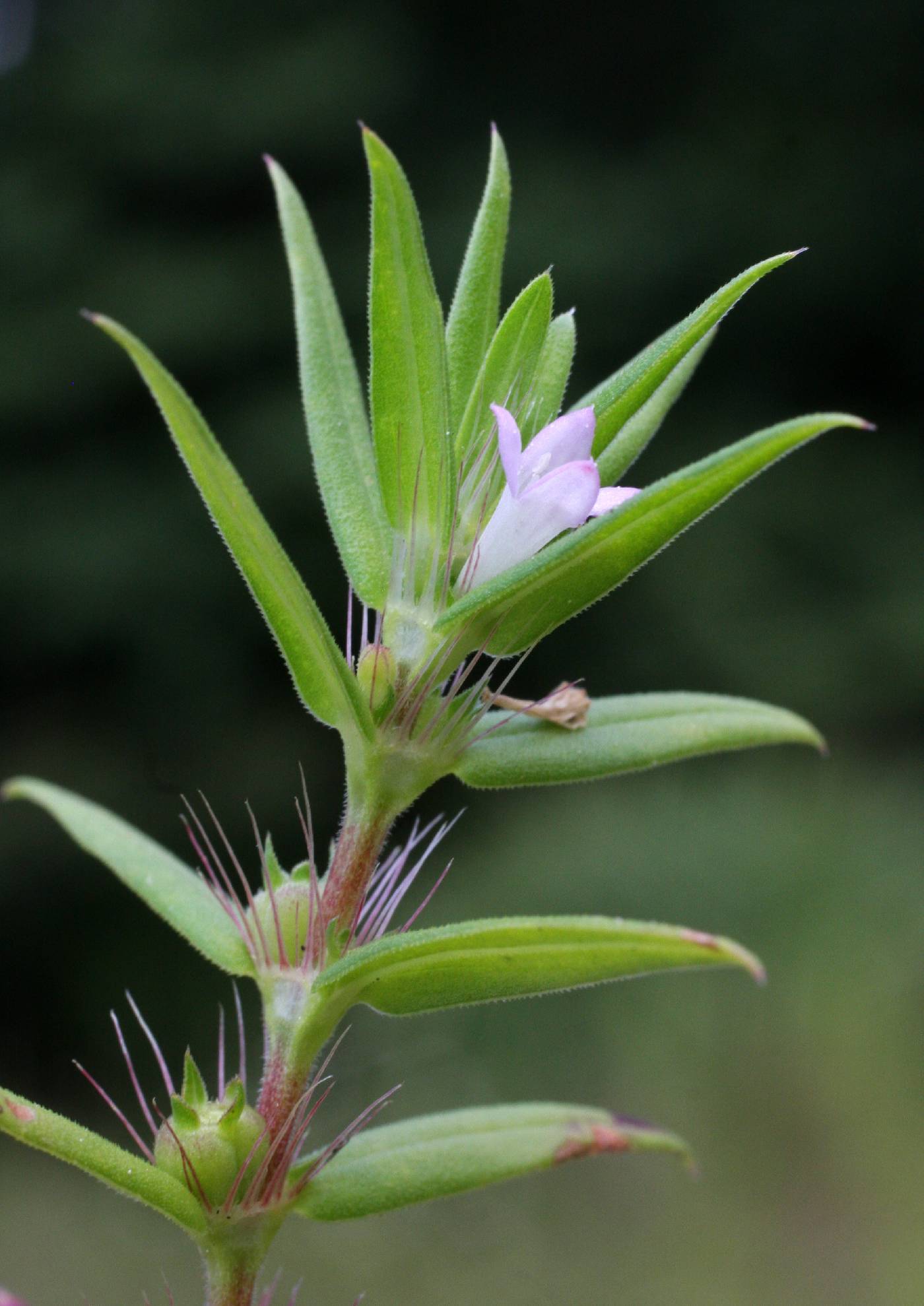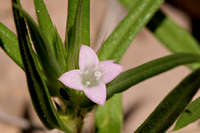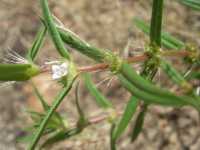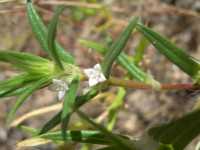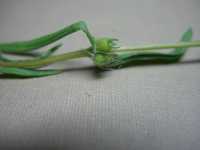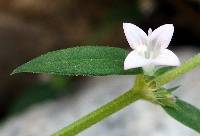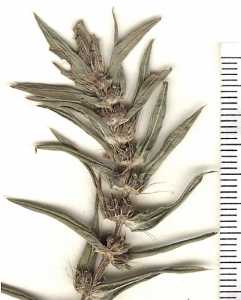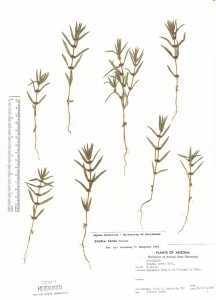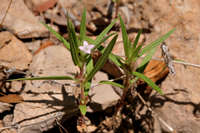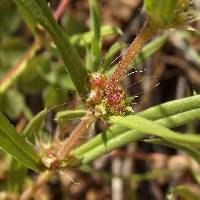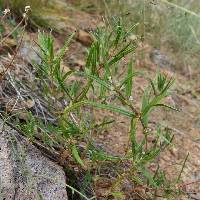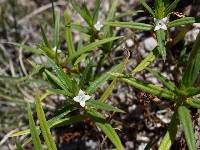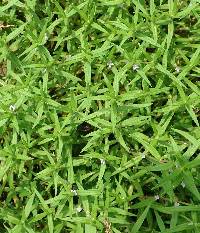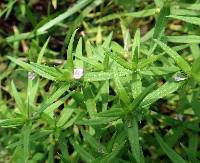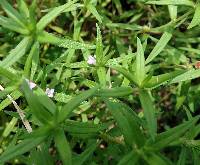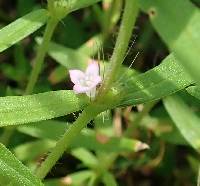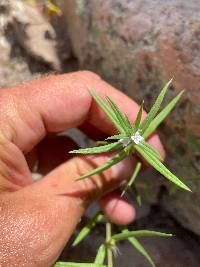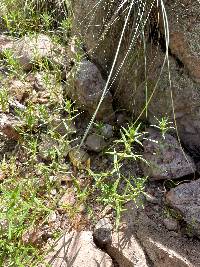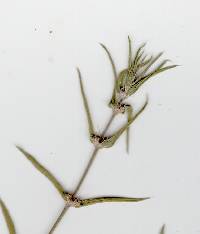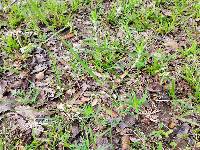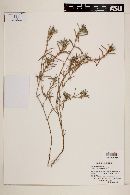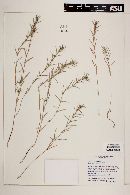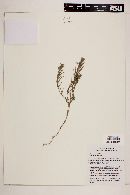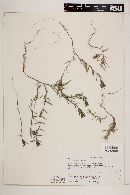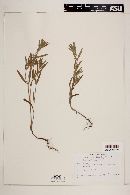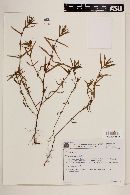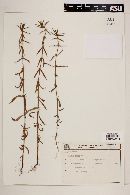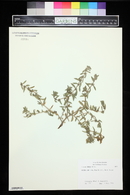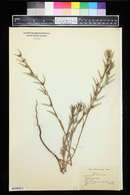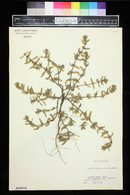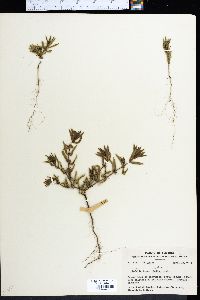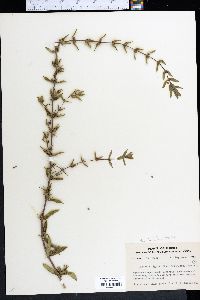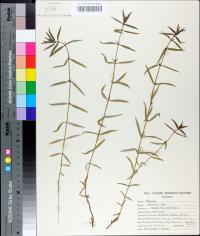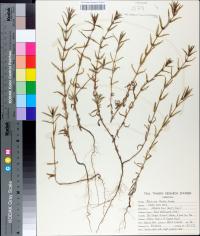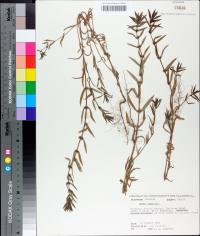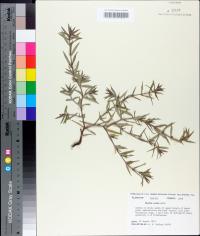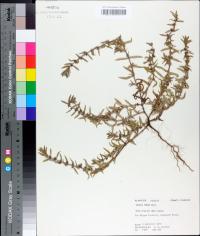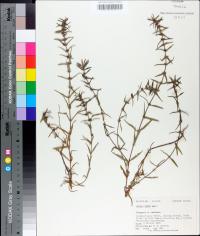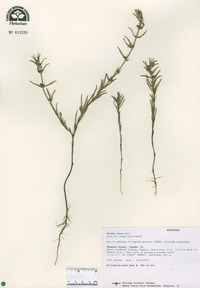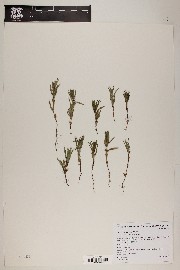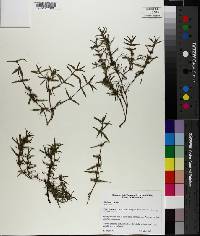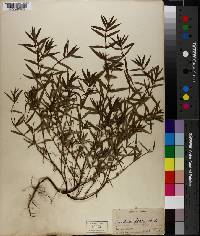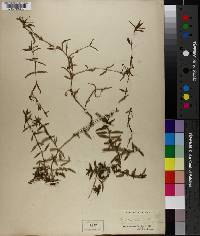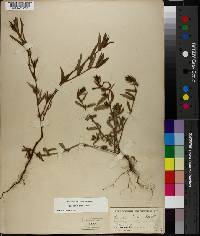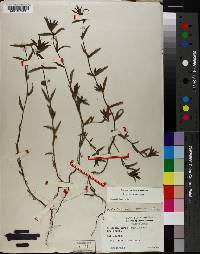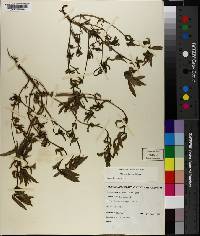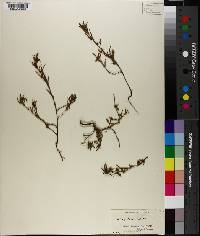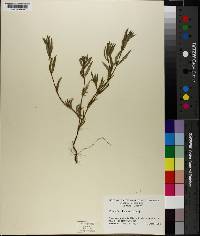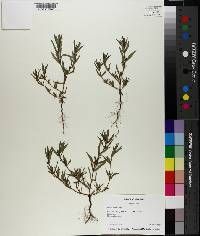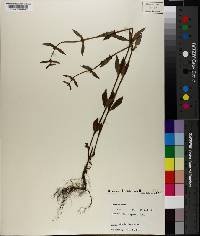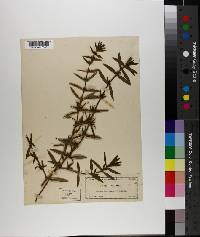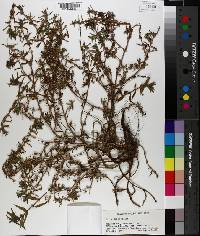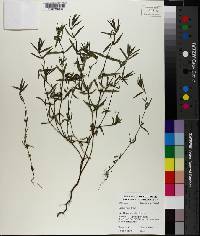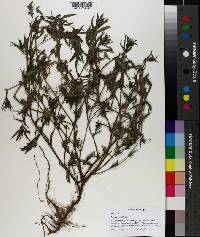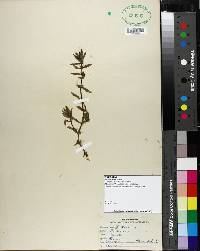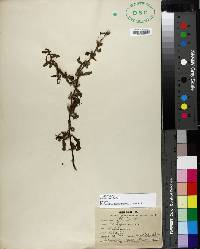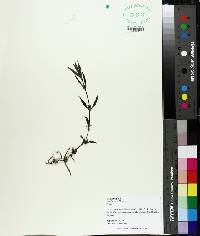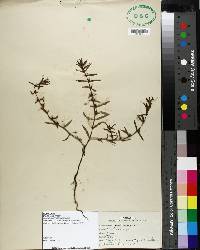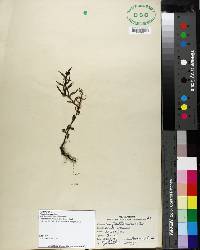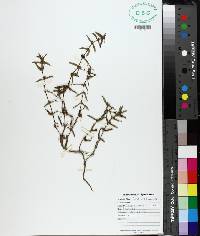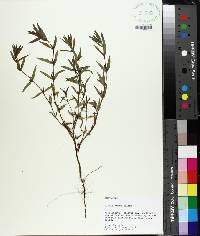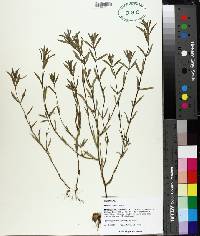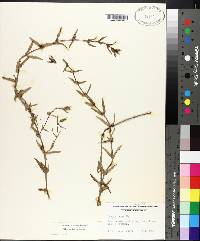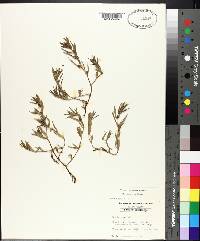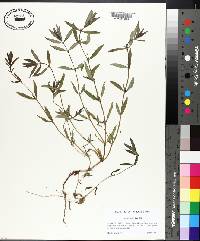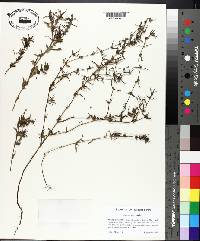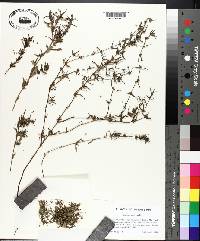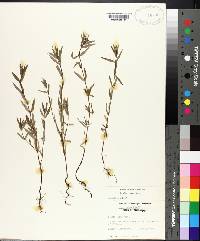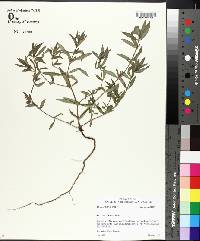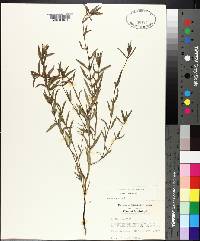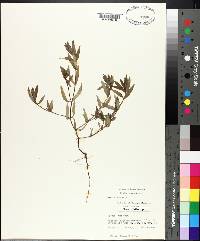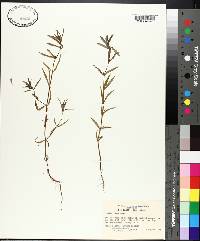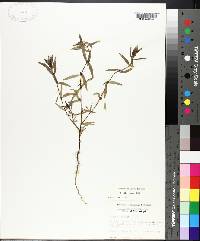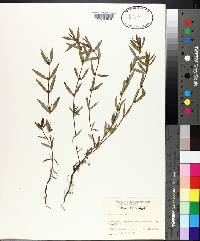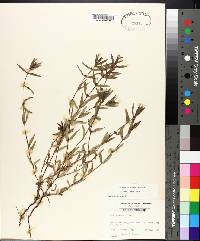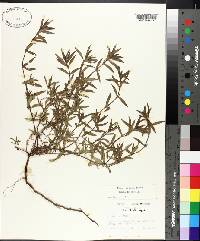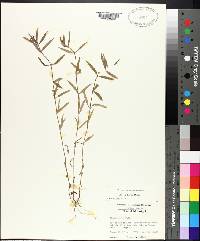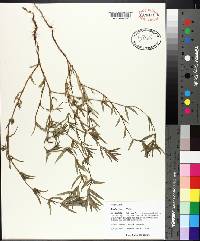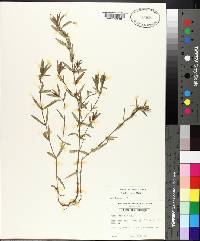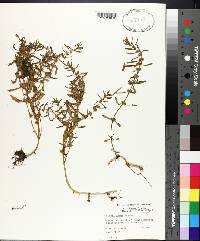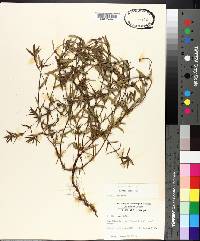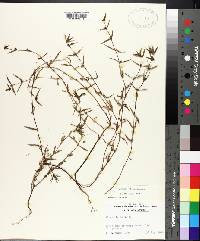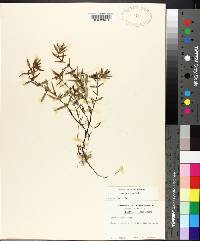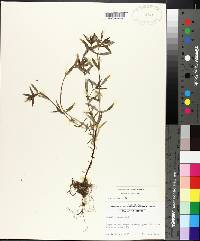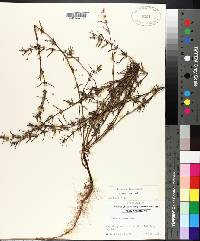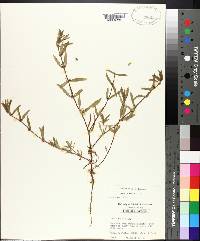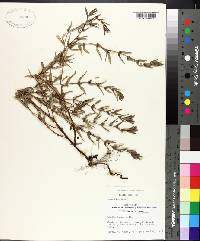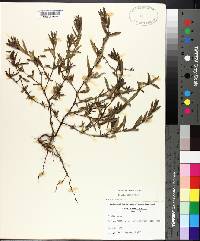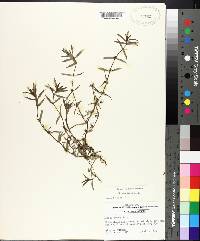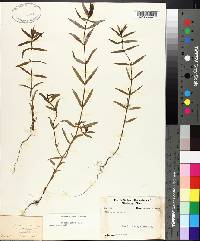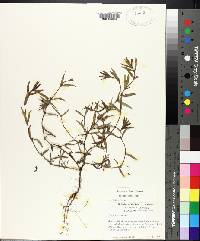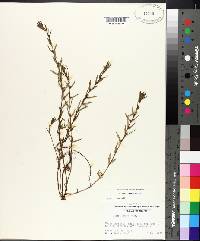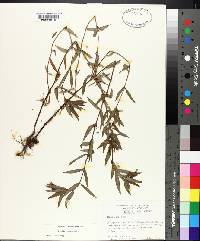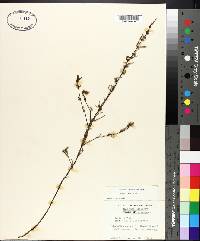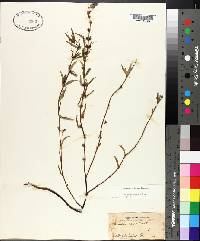
|
|
|
|
Family: Rubiaceae
Poor Joe, more...Poorjoe, poorjoe, poor joe, rough buttonweed
[Diodella teres (Walt.) Small, moreDiodia prostrata Sw., Diodia prostrata var. longiseta DC., Diodia teres Walter, Diodia teres teres , Diodia teres var. angustata A. Gray, Diodia teres var. hirsutior Fernald & Grisc., Diodia teres var. hystricina Fernald & Grisc., Diodia teres var. oblongifolia Fernald, Diodia teres var. setifera Fern. & Grisc., Diodia teres var. teres] |
Plant: annual herb; erect, 7-25 cm tall, simple or divaricately branched; stems 4-angled, at least above, glabrous or with short scattered hairs Leaves: 1.5-3.5 cm long, linear to narrowly lanceolate-oblanceolate, the apices subulate bearing a sharp terminal hair, the margins scabrous, the bases somewhat hyaline, forming with the connecting fimbriate stipules a cup containing the sessile flowers Flowers: 1-several in leaf axils; calyx lobes unequal, ovate or lanceolate, the smallest adaxial, the other 3 large and adhering to the abaxial nutlet; corolla white or pink, glabrous or hispid externally, 3 mm long, the lobes small; stamens and style included or scarcely exserted Fruit: FRUIT: nutlets 3 mm long, obovoid-turbinate, flattened at the plane of separation, covered with stiff straight, apically directed hairs, topped with persistent calyx Misc: Sandy, gravelly slopes and washes; grasslands; moist soil with oaks, pines, junipers; 1100-2450 m (3600-8000 ft); Aug-Oct REFERENCES: Dempster, Lauramay T. 1995. Rubiaceae. J. Ariz. - Nev. Sci. 29(l): 29. Annual herb with a taproot 20 cm - 0.8 m tall Stem: prostrate to upright, four-angled, branched, sparsely hairy. Leaves: opposite, stalkless, 2 - 5 cm long, to 6 mm wide, linear to narrowly lance-shaped with a pointed to bristle-like tip, sometimes minutely toothed, rough, sparsely hairy. Stipules with five to eight upright, reddish, hair-like bristles. Inflorescence: a small cluster of one to three flowers in the leaf axils. Flowers: stalkless, pale purple to white, 4 - 6 mm long, funnel-shaped, hairy externally, with four short lobes. Lobes pointed to bristle-like. Stamens four, slightly exserted. Anthers whitish to pale yellow. Fruit: a dry nutlet, indehiscent, 2.5 - 6 mm wide, egg-shaped to spherical, paired, separating when ripe, hairy, crowned with persistent sepals. Similar species: The pale purple flowers and hair-like stipular bristles are together a diagnostic characteristic of this plant. Flowering: mid-July to late September Habitat and ecology: Probably introduced from states in the south. Found along railroads in sandy soil and cinder ballast. It is also found in sandy clearings. Occurence in the Chicago region: non-native Etymology: Diodia is the Greek word for toll or thoroughfare. Teres means cylindrical (circular in cross section). Author: The Morton Arboretum Annual herb with a taproot 20 cm - 0.8 m tall Stem: prostrate to upright, four-angled, branched, sparsely hairy. Leaves: opposite, stalkless, 2 - 5 cm long, to 6 mm wide, linear to narrowly lance-shaped with a pointed to bristle-like tip, sometimes minutely toothed, rough, sparsely hairy. Stipules with five to eight upright, reddish, hair-like bristles. Inflorescence: a small cluster of one to three flowers in the leaf axils. Flowers: stalkless, pale purple to white, 4 - 6 mm long, funnel-shaped, hairy externally, with four short lobes. Lobes pointed to bristle-like. Stamens four, slightly exserted. Anthers whitish to pale yellow. Fruit: a dry nutlet, indehiscent, 2.5 - 6 mm wide, egg-shaped to spherical, paired, separating when ripe, hairy, crowned with persistent sepals. Similar species: The pale purple flowers and hair-like stipular bristles are together a diagnostic characteristic of this plant. Flowering: mid-July to late September Habitat and ecology: Probably introduced from states in the south. Found along railroads in sandy soil and cinder ballast. It is also found in sandy clearings. Occurence in the Chicago region: non-native Etymology: Diodia is the Greek word for toll or thoroughfare. Teres means cylindrical (circular in cross section). Author: The Morton Arboretum Dempster 1995 Duration: Annual Nativity: Native Lifeform: Forb/Herb General: Erect annuals, 7-25 cm tall; stems simple or divaricately branched, terete below and often four-angled above, glabrous, or with short scattered hairs. Leaves: Opposite and sessile, with connecting fimbriate stipules; blades 1.5-3.5 cm long, linear to narrowly lanceolate-oblanceolate, with subulate apices tapering to a sharp terminal hair; margins scabrous; bases somewhat hyaline, forming with the fimbriate stipules a cup that contains the sessile flowers. Flowers: White to pink, solitary or clustered in leaf axils; calyx with 2-4 unequal ovate or lanceolate lobes, the 3 largest lobes adhering to the lower nutlet; corolla white or pink, funnelform and topped with 4 lobes, glabrous or hispid externally, 3 mm long; 4 stamens and 1 style included or scarcely exserted from corolla. Fruits: Pair of nutlets 3 mm long, obovoid-turbinate, flattened at plane of separation, covered with stiff straight, apically directed hairs, topped with persistent calyx. Ecology: Found on sandy, gravelly slopes and along washes, often in disturbed soils from 3,500-8,000 ft (1067-2438 m); flowers August-October. Distribution: CA east to LA and north to the Midwest, much of the East Coast; south to S. Amer.; also in Asia and Australia. Notes: The small four-petaled flowers to make you think Houstonia or Hedyotis, but this species is delicately annual and with the connective stipules, quite unlike the close ground habit of the other two genera. Ours are thought to be of var. angustata. Ethnobotany: Unknown Etymology: Diodia is from the Greek for thoroughfare, probably referring to the roadside habitat of Diodia virginiana, the first species of the genus to be described by Linneus; while teres means terete or cylindrical in cross-section, in this case referring to the stem. Synonyms: None, but several varieties, see Tropicos Editor: SBuckley 2010, FSCoburn 2015, AHazelton 2015 Annual with prostrate to spreading or ascending stems 2-8 dm; lvs stiff, sessile, linear to narrowly lanceolate, 2-4 cm, scabrous, aristate; stipules 4-10 mm, with a short sheath and 5-8 ascending or erect setaceous bristles; fls in many of the upper axils; sep 4, lanceolate, 2 mm; cor funnelform, white to pale purple, 5-6 mm; style capitate; fr obovoid, hairy, 2.5-6 mm, crowned by the persistent sep; 2n=28. Dry or sandy soil, often weedy; s. N. Engl. to s. Wis., Io. and Kans., s. to trop. Amer. June-Sept. (Diodella t.) Gleason, Henry A. & Cronquist, Arthur J. 1991. Manual of vascular plants of northeastern United States and adjacent Canada. lxxv + 910 pp. ©The New York Botanical Garden. All rights reserved. Used by permission. From Flora of Indiana (1940) by Charles C. Deam Generally in hard, poor clay soil in pastures, fallow and wheat stubble fields, and clearings, on the crests of open woods, and along roadsides and railroads. It is restricted mostly to the southern half of the state although we have a few reports from the northern part of the state along railroads. The pubescence of the stem of all my specimens is dense, spreading, and less than 0.5 mm long. A few specimens have in addition a few long spreading hairs about 1 mm long. ...... Indiana Coefficient of Conservatism: C = 2 Wetland Indicator Status: FACU |
|
|
|

